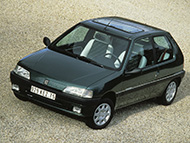From Peugeot Press Release
The PEUGEOT 106 will be celebrating its historic 30th anniversary in September 2021. First launched on 12 September 1991, the PEUGEOT 106 was produced as a three-door model, and then a five-door model from 1992. Production for the model ended in 2003, having sold 2,800,000 cars.
The PEUGEOT 106 was introduced to broaden PEUGEOT's offering in the B-segment, which accounted for just over a third of all European registrations at the time.
Upon launch in 1991, the PEUGEOT 106 was introduced as "a ball of sympathy wrapped in smiles and dressed in charm that feels so perfectly at home in its 3.56m of surprises and amazement.”
The PEUGEOT 106 was mainly manufactured in Mulhouse, Eastern France, but once customer demand for the car grew factories in Sochaux and Aulnay-sous-bois also welcomed the model onto its production lines. The PEUGEOT 106 was front-wheel drive available with petrol engines sizes from 954 to 1587cm3 and Diesel models from 1360 to 1558cm3.
Across 12 years of the PEUGEOT 106’s production, around 20 different special series models were produced. The most iconic were the very beautiful "Roland Garros" and "Zenith" which appeared in 1993, the famous 106 Kid and its jean seats in 1994, the very fun 106 Cartoon presented by Droopy from 1996 to 1999, the elegant "Inès de la Fressange" in 1997, and the Enfant Terrible marketed in 2000.
The car also came in sports versions with the 106 Rallye in 1993, the 106 XSI with 95hp in 1992 and 105hp in 1995, and the 106 S16 120hp in 1996 for its last year on the market. All are highly sought after today. The PEUGEOT 106 saw success across PEUGEOT Sport meetings and in Group N rallies. In 1997, the 106 Maxi was unveiled, inspired by the 306 Maxi. Developed and driven by Lionel Montagne from 1998, it was driven by Cédric Robert in 2000 who finished 5th in the French Rally Championship.
PEUGEOT was a forerunner of the electric car with the first ‘VLV’ (Voiture Légère de Ville, or ‘electric city car’) presented in 1941. The PEUGEOT 106 was the second and went on to hold the world record for electric car sales until 2010. The electric version sold nearly 3,550 units and was aimed at both private and fleet customers.
The PEUGEOT 106 has been the mainstay of emblematic advertising campaigns based mostly on humour with the famous slogan “A gentleman will do anything to borrow his wife’s car”.
The PEUGEOT Aventure Museum in Sochaux is dedicating an exhibition to the PEUGEOT 106 until the end of 2021. Eight models will be on display for the anniversary: 106 Rallye (Italian version) from 1994, 106 XSI from 1992, 106 Signature from 1995, 106 S16 from 1997, 106 Enfant Terrible from 2002, 106 Electric from 1996, 106 Maxi from 1997 and a prototype 106 Cabriolet from 1992.
The Museum teams are also preparing a large gathering of PEUGEOT 106s with the 106 Team Rally Club and the 106 S16 Club on Saturday 11 September 2021. All PEUGEOT 106 owners will be welcome. To find out more: www.museepeugeot.com



